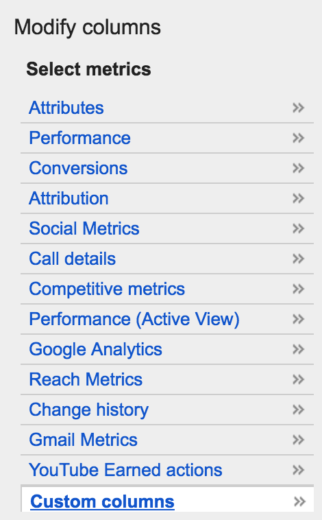Return on ad spend (ROAS), cost per lead (CPL), and click-through rate (CTR) are some of the go-to metrics for clients in order to gauge paid search success. I’m sure there are more you can think of, but the majority of the statistics used to gauge success are already listed in the AdWords platform for you to visualize. What I am here to tell you is that there are other metrics out there. Ones that do not necessarily exist within the platform itself but can be created by the information given to you.
Custom Metrics And Separating Google Performance
Some of what we are talking about today can actually be created within AdWords through the metrics feature in the custom columns.

I briefly explained this tool in a previous post on how to visualize your account performance changes since Google’s removal of the sidebar ads. With this tool, I’ve created many metrics.
Top of Page Impression % on Google – Google Top Impressions/Google Impressions (shows you out of your Google impressions only, how many are showing on top of the page)
Google Only Click-through Rate – Google Clicks/Google Impressions (Takes Search Partners out of the equation for you without having to use segments)
Cost per Top of Page Click – Top of Page Cost/Top of Page Click (Shows how much more expensive the top of the page is than ads showing elsewhere without having to use segments)
These are just a few custom metrics I created in light of the no sidebar ad changes in order to visualize performance a bit differently. With this being said, I do encourage AdWords users to utilize custom metrics, but the best place to create your own metrics continues to be Excel since the options are unlimited.
Clicks Per Query: Finding It And Why It’s Important
One of the statistics I like to look at the most in Excel is the Clicks per Potential Impression (or Clicks per Query). Many users like to see traffic continue to flow in at the same rate and look at CTR in order to visualize if they are getting the same amount of traffic per each chance they have at a click. However, this data does not always tell the whole story. It’s similar to using average position for your bidding processes. It’s not necessarily the wrong route to take, but you aren’t using the whole story to base your optimizations. The best example I could see here is the following:
You have a broad match keyword of “jeans.” You’re bidding $5 on this term and receive the following results:
- jeans: 100 clicks, 1,000 impressions, 2,000 times users looked up jeans
- blue jeans: 50 clicks, 800 impressions, 1,500 times users looked up blue jeans
- skinny jeans: 20 clicks, 500 impressions, 1,500 times users looked up skinny jeans
You lower the bid to $4 and receive the following results:
- jeans: 80 clicks, 900 impressions, 2,000 times users looked up jeans
- blue jeans: 25 clicks, 425 impressions, 1,500 times users looked up blue jeans
- skinny jeans: 1 click, 50 impressions, 1,500 times users looked up skinny jeans
If you do the math, you’ll see week over week after we lowered our bid we saw a higher CTR from 7.39% to 8.00%. Great news, right? We are getting cheaper traffic and a larger piece of the pie since our CTR went up. This is where you’re wrong and should really be looking into Click per Query. As the number of times each term was looked up was given to you, you can see that the Click per Query went from 3.4% all the way down to 2.12%.

But Google doesn’t give you the number of searches, so how would you go about figuring this out? Simply take impressions/impression share in order to find the potential impressions or queries and then take clicks/potential impressions. The whole formula would be: (clicks/(impressions/impression share)).
Ad Testing Metrics
For ad testing, many advertisers use CTR in order to determine the top performing ads. This route is the correct way to go if the goal is to receive traffic. But it is not always the right way to go about ad testing.
At this point you’re probably saying “Wait a minute Jake, or Juice or whatever they call you, we’re noticing you’re sending us to all of your past articles throughout this article. What kind of self-righteous person are you?”
But trust me, I am so humble. And not all of my links are to my own articles. Some are funny Andy Sandberg songs from his new hit movie Popstar! (Now you’re wondering if Andy Sandberg paid me to say this on the most read PPC blog in the US. Well to answer your question there, we’re not quite that important YET, so no he didn’t).
And we move on.
Below shows the different metrics we use for ad copy testing (outside of CTR) and why:
Conversion (or Converted Click)/Impression – Used when the goal of an account is CPL or to garner conversion volume. Takes into consideration the CTR and conversion rates.
Revenue/Impression – Used when the goal of the account is ROAS. This metric takes into consideration the CTR, the conversion rate, and the average order value.
“Engaged User”/Impressions – Used when the goal is to bring interested users who are engaged with the site. This is not a perfect metric, but is one I used often to estimate the number of engaged users I am receiving, and it works well for ad testing. The formula to get a projected engaged user metric would be: Clicks*(1-Bounce Rate).
Creating A Point System
A lot of times you need to keep your eye on multiple statistics as you try to move the quality of an account forward. Direct revenue, calls, average time on site, bounce rates, assisted conversions, etc. all need to be accounted for. The best way to do so is to base optimizations off of the most important metrics. But it is not always easy to find the most important metrics. This is where a point system can come into play.
Engagement Metrics – Try to work out a formula to gauge how much an engagement metric is worth to you. An example is finding how likely a person who did not bounce is to convert later in the process, and take that likelihood multiplied by your typical average order value and rate these customers with that value.
Calls – How often do calls turn into a sale? Take that percentage multiplied by the AOV and you can get the typical value of a call.
Conversions and/or Sales – Decide how much a conversion typically is worth to you, or track the exact revenue and measure sales this way.
Assisted Conversions – This metric is trickier and is where different attribution models can come into play. Sometimes you can just put a value on assisted conversion to add into your points system.
From here, add up all the points based on the values you’ve given to these different categories and optimize based on the number of points a keyword brings an account rather than one or the other metrics. This can get extremely tricky, but bringing everything into one spot is crucial when deciding on bid changes, which ads won an ad copy test, which locations to target and almost any other optimization that comes to mind.
Conclusion
Analytical and creative are two words constantly used in our industry. Don’t just stick to what is in front of you. Be analytical and creative, finding different ways to look at results that make the most sense for your particular account.



